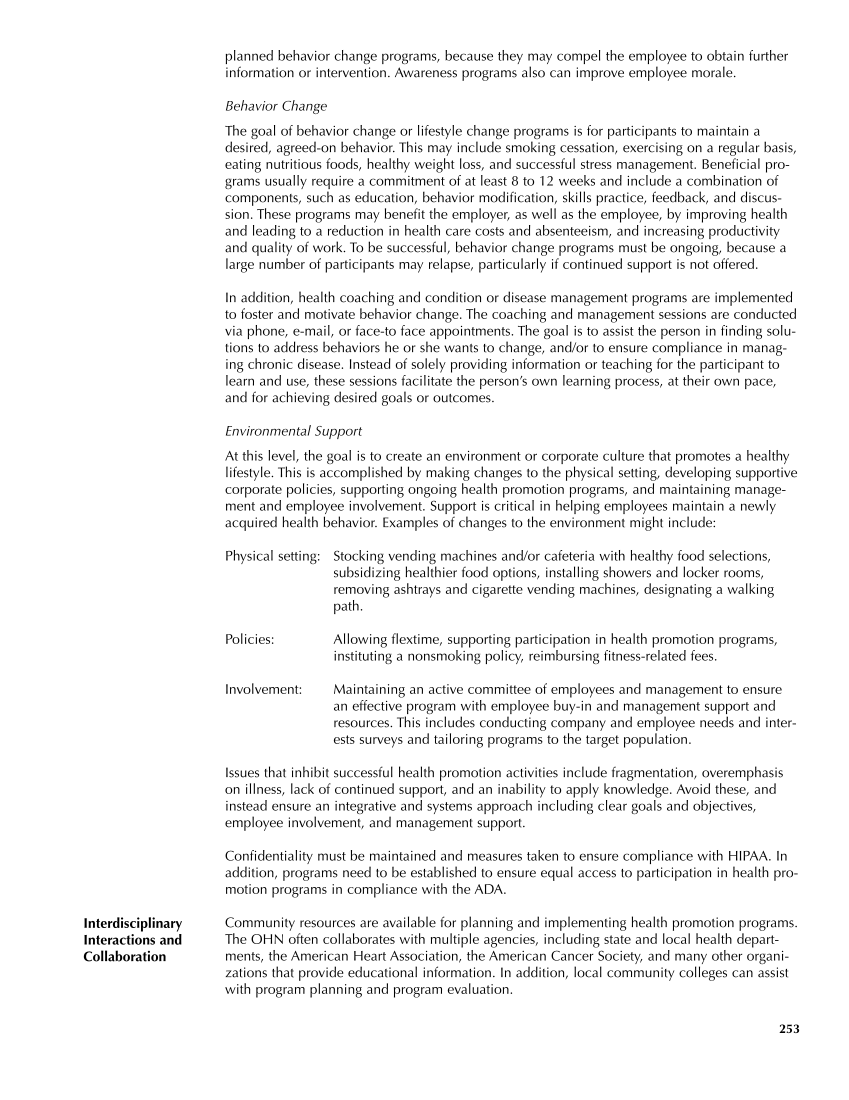planned behavior change programs, because they may compel the employee to obtain further information or intervention. Awareness programs also can improve employee morale. Behavior Change The goal of behavior change or lifestyle change programs is for participants to maintain a desired, agreed-on behavior. This may include smoking cessation, exercising on a regular basis, eating nutritious foods, healthy weight loss, and successful stress management. Beneficial pro- grams usually require a commitment of at least 8 to 12 weeks and include a combination of components, such as education, behavior modification, skills practice, feedback, and discus- sion. These programs may benefit the employer, as well as the employee, by improving health and leading to a reduction in health care costs and absenteeism, and increasing productivity and quality of work. To be successful, behavior change programs must be ongoing, because a large number of participants may relapse, particularly if continued support is not offered. In addition, health coaching and condition or disease management programs are implemented to foster and motivate behavior change. The coaching and management sessions are conducted via phone, e-mail, or face-to face appointments. The goal is to assist the person in finding solu- tions to address behaviors he or she wants to change, and/or to ensure compliance in manag- ing chronic disease. Instead of solely providing information or teaching for the participant to learn and use, these sessions facilitate the person’s own learning process, at their own pace, and for achieving desired goals or outcomes. Environmental Support At this level, the goal is to create an environment or corporate culture that promotes a healthy lifestyle. This is accomplished by making changes to the physical setting, developing supportive corporate policies, supporting ongoing health promotion programs, and maintaining manage- ment and employee involvement. Support is critical in helping employees maintain a newly acquired health behavior. Examples of changes to the environment might include: Physical setting: Stocking vending machines and/or cafeteria with healthy food selections, subsidizing healthier food options, installing showers and locker rooms, removing ashtrays and cigarette vending machines, designating a walking path. Policies: Allowing flextime, supporting participation in health promotion programs, instituting a nonsmoking policy, reimbursing fitness-related fees. Involvement: Maintaining an active committee of employees and management to ensure an effective program with employee buy-in and management support and resources. This includes conducting company and employee needs and inter- ests surveys and tailoring programs to the target population. Issues that inhibit successful health promotion activities include fragmentation, overemphasis on illness, lack of continued support, and an inability to apply knowledge. Avoid these, and instead ensure an integrative and systems approach including clear goals and objectives, employee involvement, and management support. Confidentiality must be maintained and measures taken to ensure compliance with HIPAA. In addition, programs need to be established to ensure equal access to participation in health pro- motion programs in compliance with the ADA. Community resources are available for planning and implementing health promotion programs. The OHN often collaborates with multiple agencies, including state and local health depart- ments, the American Heart Association, the American Cancer Society, and many other organi- zations that provide educational information. In addition, local community colleges can assist with program planning and program evaluation. 253 Interdisciplinary Interactions and Collaboration
Purchased from OEM Press by (ge corporate access). (C) 2013 OEM Health Information, Inc. All rights reserved.












































































































































































































































































































































































































































